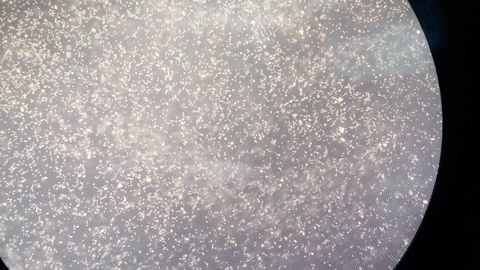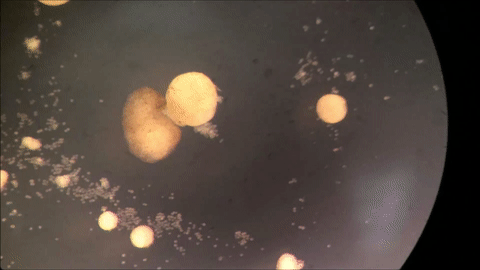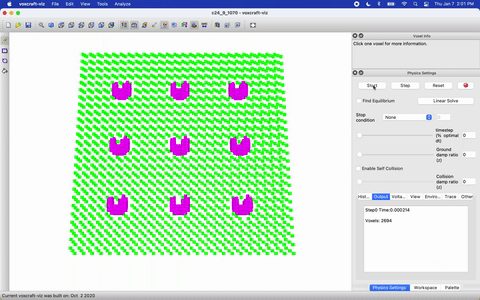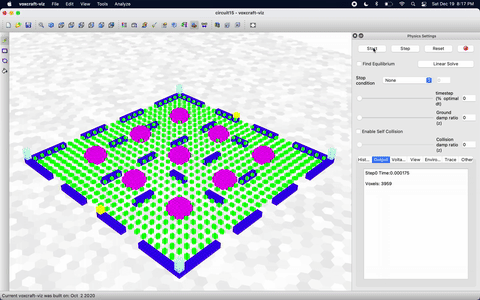Videos
All videos are licensed under CC BY 4.0.
Please credit: “Douglas Blackiston and Sam Kriegman”.
Watch the full videos on youtube or download them using the links below each gif preview.

Kinematically replicating organisms (KROs) piling loose stem cells.
youtube |
download

AI-controlled self-replication: AI-generated C-shaped parents collect and compress loose stem cells together into piles which, if sufficiently large, will mature into motile offspring.
youtube |
download

Sculpting two of the AI-generated designs using a microcautery electrode.
youtube |
download

Movement of an AI-designed parent.
youtube |
download

Shaping the AI-generated ring design using a glass capillary.
youtube |
download

Movement of an AI-designed parent shaped like a ring through water.
youtube |
download

Movement of an AI-designed parent (ring shape) through water.
youtube |
download

C-shaped parent collects cells in its “mouth” as it builds offspring from loose stem cells.
youtube |
download

C-shaped parent aggregates loose stem cells into a pile of stem cells (incipient offspring).
youtube |
download

C-shaped parent rotating a large ball of stem cells (incipient offspring).
youtube |
download

C-shaped parents building their offspring.
youtube |
download

A computer simulation was created in which a swarm of nine simulated frog-cell parents (pink) build piles out of simulated adhesive frog stem cells (green) that are strewn across the bottom of a simulated petri dish. The default body shape of parents (and their children) is a sphere: this is what the stem cells “want” to make (due to surface tension) when brought together. The default spherical parents (pink) often fail to self replicate in simulation.
youtube |
download

Occasionally the spheres can reproduce in simulation.
youtube |
download

AI-designed toruses reproduce more often than the default spheres because they are more flexible: their bodies slightly deform around collections of stem cells (green) like a shovel.
youtube |
download

AI-designed H shapes are even better: they reproduce more often than toruses or the default spheres.
youtube |
download

The best design was a C shape (Macaroni).
youtube |
download

Variations on the C shape proposed by AI included a design with a long narrow mouth (PacMan).
youtube |
download

Another C-shape variant proposed by AI resembled a half donut.
youtube |
download

A dozen half-donuts.
youtube |
download

Progressively larger offspring. In contrast to other known forms of biological reproduction, kinematic self replication allows for the opportunity to significantly enlarge and miniaturize offspring, each generation.
youtube |
download

Exponential growth. If the simulated progenitors are left in the dish, they can assist in building future generations of offspring.
youtube |
download

Predicted piling behavior of the AI-designed parent swarms matches the living systems.
youtube |
download

Another example of piling behavior predicted of the C-shape.
youtube |
download

Exponential utility. A swarm of self-replicating semitoroidal organisms (pink) was placed inside a partially-completed circuit (blue) in which current (yellow) flows through adhesive wires (blue) from batteries to light emitters. As a side effect of movement, organisms will randomly push together microelectronics modules present in the dish. If a light emitter connects by an unbroken circuit of wire to a battery, the light emitter switches on permanently (yellow). Dissociated stem cells (green), if pushed into piles, develop into offspring (irregularly shaped pink masses) that assist in circuit building.
youtube |
download

Another circuit.
youtube |
download

Exponential utility. Each branch represents replication; red branches denote circuit completion.
youtube |
download

Evolved terrain. The algorithm was modified to evolve terrain shape rather than progenitor shape to amplify self replication. Terrain was shaped by the inclusion of reconfigurable walls (black) that, once positioned along the bottom surface of the simulated dish, constrain the stochastic movement of organisms along more predictable trajectories within predefined limits.
youtube |
download

Another evolved terrain.
youtube |
download

In a cluttered environment (black “boulders”), the wild type progenitors (spheroids) cannot move enough to self replicate.
youtube |
download

The algorithm not only can amplify self replication in a given environment but can also bestow this capability on swarms otherwise incapable of achieving it in adverse environments. The algorithm discovered progenitor shapes with ventral surfaces that elevated the simulated organisms above the clutter while maintaining frontal plane curvatures that facilitated pile making and the achieving of self replication.
youtube |
download